
Operation Compass was the first large British military operation of the Western Desert Campaign (1940–1943) during the Second World War. British, Indian, Commonwealth and Allied forces attacked Italian forces of the 10th Army in western Egypt and Cyrenaica, the eastern province of Libya, from December 1940 to February 1941.
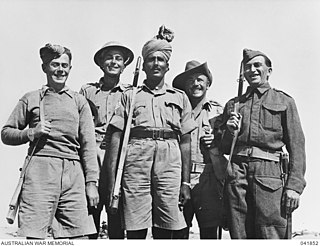
The Siege of Tobruk lasted for 241 days in 1941, after Axis forces advanced through Cyrenaica from El Agheila in Operation Sonnenblume against Allied forces in Libya, during the Western Desert Campaign (1940–1943) of the Second World War. In late 1940, the Allies had defeated the Italian 10th Army during Operation Compass (9 December 1940 – 9 February 1941) and trapped the remnants at Beda Fomm. During early 1941, much of the Western Desert Force (WDF) was sent to the Greek and Syrian campaigns. As German troops and Italian reinforcements reached Libya, only a skeleton Allied force remained, short of equipment and supplies.
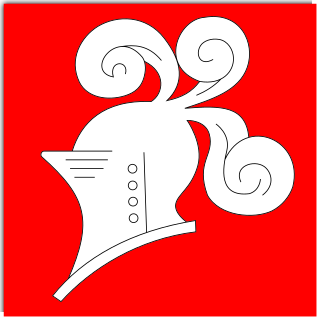
The 2nd Armoured Division was a division of the British Army that was active during the early stages of the Second World War. The division's creation had been discussed since the beginning of 1939, with the intent to form it by splitting the 1st Armoured Division. A lack of tanks delayed this until December 1939. For a short period after its creation, the division had no assigned units until the 1st Light Armoured Brigade was assigned to it from the 1st Armoured Division, and the 22nd Heavy Armoured Brigade from Southern Command.
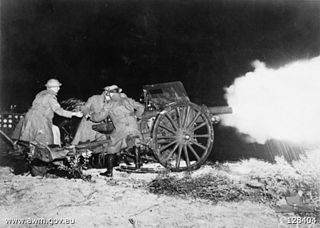
The 1st Regiment, Royal Australian Artillery is a close support regiment attached to the 7th Brigade at Enoggera Barracks in Queensland. The unit was formed in 1914 under the name 1st Australian Field Artillery Brigade, part of 1st Division Artillery during World War I and later served in World War II and the Vietnam War. It is currently re-equipping with M777A2 lightweight towed howitzers.
3rd Regiment Royal Horse Artillery is a regiment of the Royal Horse Artillery in the British Army. They are currently based at Albemarle Barracks, Northumberland, England.
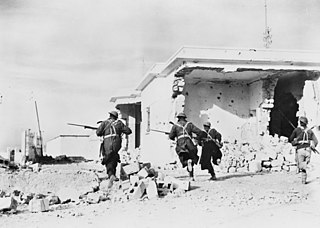
The Battle of Bardia was fought between 3 and 5 January 1941, as part of Operation Compass, the first British military operation of the Western Desert Campaign of the Second World War. It was the first battle of the war in which an Australian Army formation took part, the first to be commanded by an Australian general and the first to be planned by an Australian staff. The 6th Australian Division assaulted the strongly held Italian fortress of Bardia, Libya, assisted by air support and naval gunfire and under the cover of an artillery barrage. The 16th Australian Infantry Brigade attacked at dawn from the west, where the defences were known to be weak. Sappers blew gaps in the barbed wire with Bangalore torpedoes and filled in and broke down the sides of the anti-tank ditch with picks and shovels. This allowed the infantry and 23 Matilda II tanks of the 7th Royal Tank Regiment to enter the fortress and capture all their objectives, along with 8,000 prisoners.
This is the order of battle for Operation Brevity, a World War II battle between the British Commonwealth and the European Axis Powers of Germany and Italy in North Africa between May 15–16, 1941.

'A' Field Battery is an artillery battery of the Australian Army. The unit has been in existence since 1871, having originally been raised as part of the New South Wales colonial defence force. As part of several different larger formations, the battery has served in many conflicts including the Sudan Campaign, the Second Boer War, the First World War, the Second World War, the Malayan Emergency, Confrontation, and the Vietnam War. Today it is part of the 1st Regiment, Royal Australian Artillery, attached to the 7th Brigade based at Enoggera, Queensland. It was previously an airborne unit, but no longer maintains that role. It is currently equipped with M777 howitzers.
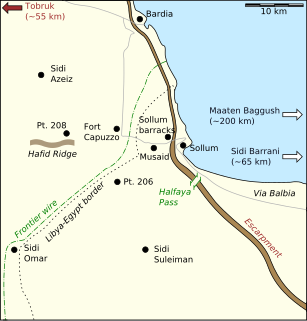
Operation Skorpion from 26 to 27 May 1941, was a military operation during the Western Desert Campaign of the Second World War. The operation was conducted by Axis forces under the command of Colonel Maximilian von Herff and British forces under Lieutenant-General William "Strafer" Gott. A counter-attack was made on British positions at Halfaya Pass in north-western Egypt, which had been captured during Operation Brevity (15–16 May).Unternehmen Skorpion was the second offensive operation commanded by Rommel in Africa.

The 2/4th Field Regiment was an Australian Army artillery regiment formed on 2 May 1940, as part of the 7th Division during World War II. The regiment was involved in campaigns in North Africa, Syria–Lebanon, Salamaua–Lae, the Finisterre Ranges and Borneo. After training in Victoria, the regiment deployed to North Africa in late 1940. After being deployed in the defence of Mersa Matruh in Egypt in early 1941, the regiment took part in the fighting against the Vichy French in Syria and Lebanon, before undertaking garrison duties there. It returned to Australia in early 1942 following Japan's entry into the war, and in September 1943, a small group of artillerymen from the 2/4th parachuted with two short 25 Pounder guns in the airborne landing at Nadzab airstrip in New Guinea in support of the US Army's 503rd Parachute Infantry Regiment. Later, the regiment took part in the 7th Division's advance through the Finisterre Range before returning to Australia in early 1944. Its final involvement in the war came around Balikpapan in 1945. After the war, the regiment was disbanded on 7 February 1946.

The 2/1st Field Regiment was an Australian Army artillery regiment raised as part of the all volunteer Second Australian Imperial Force during World War II. Formed in October 1939, the regiment was assigned to the 6th Division. Shortly after it was raised, the regiment was deployed to the Middle East, where it was briefly re-roled as an anti-aircraft regiment before returning to the field artillery role. In 1941, the regiment served in North Africa and in Greece, before being withdrawn back to Australian in early 1942, following Japan's entry into the war. In late 1942, and early 1943, the regiment took part in the defence of Port Moresby during the fighting along the Kokoda Track, before taking part in the Battle of Buna–Gona and the defence of Wau, remaining in New Guinea on garrison duties until August 1943. Withdrawn to Australia, a long period of training followed before the regiment took part in its final campaign of the war Aitape–Wewak campaign in 1945.

The 2/3rd Field Regiment was an Australian Army field artillery regiment that was raised for service during the Second World War. Formed in 1939 and assigned to the 6th Division, the regiment was deployed to the United Kingdom to defend against a possible invasion in 1940 before being sent to North Africa, where it briefly saw action prior to being sent to Greece and Crete in 1941. In 1942, the regiment returned to Australia, after which it did not see action again until late in the war when it was committed to the Aitape–Wewak campaign in 1944–45. Following the end of the war, the regiment returned to Australia and was disbanded in January 1946.

The 2/7th Field Regiment was an Australian Army field artillery regiment that served during the Second World War. Formed in mid-1940 and assigned to the 9th Division, the regiment was deployed to North Africa, where it saw action around Tobruk in 1941 and in the First and Second Battles of El Alamein in 1942. It also undertook garrison duties in Syria and Egypt. In 1943, the regiment returned to Australia, after which it did not see action again until late in the war when it was committed to the landing at Tarakan in 1945. Following the end of the war, the regiment returned to Australia and was disbanded in January 1946.

The 2/14th Field Regiment was an Australian Army artillery unit that served during the Second World War. Raised in late 1940 as part of the 8th Division, the regiment remained in Australia as a garrison force in Darwin when the division's infantry brigades were sent to various places around Southeast Asia to meet the threat posed by Japan. As a result, it did not deploy overseas until late 1943. In New Guinea, the regiment supported the 5th Division's operations on the Huon Peninsula throughout 1944 before deploying with them to New Britain in early 1945. From then, until the end of the war, the regiment engaged in operations against the large Japanese garrison on the island. At the end of the war, the 2/14th briefly undertook garrison duties on Rabaul as part of the 11th Division before returning to Australia and disbanding in January 1946.

The 2/11th Field Regiment was an Australian Army artillery regiment formed as part of the Second Australian Imperial Force during World War II. Formed in Victoria in mid-1940, the regiment was deployed to the Middle East in 1941 and subsequently took part in the fighting against the Vichy French in the Syria–Lebanon Campaign. In early 1942, they were brought back to Australia in response to Japan's entry into the war, and in 1943 joined the garrison in Darwin. Throughout 1944–45, the regiment was deployed to New Guinea before supporting the 3rd Division's campaign on Bougainville. After the war, the regiment was disbanded.

The 2/6th Field Regiment was an Australian Army artillery regiment formed as part of the 7th Division in May 1940 for operations during World War II. The regiment served in Egypt and Syria in 1941–1942 before returning to Australia after Japan's entry in the war. Throughout 1943 and 1944, the regiment served against the Japanese in New Guinea. The regiment's involvement in the fighting in New Guinea saw it committed to several campaigns, including those around Salamaua and on the Huon Peninsula. Its final campaign of the war was fought on Borneo in mid-1945. Shortly after the conclusion of hostilities, the regiment was disbanded in late 1945.

The 2/4th Anti-Tank Regiment was an Australian Army anti-tank artillery regiment that was raised for service during the Second World War as part of the all volunteer Second Australian Imperial Force. It was formed in November 1940, and was assigned to the 8th Division. In early 1942, the regiment took part in the Malayan campaign and the Battle of Singapore before being captured when Singapore fell to the Japanese at which time most of its personnel became prisoners of war. Over 170 members of the regiment died in captivity before the end of the war in August 1945.

The 2/1st Anti-Tank Regiment was an Australian Army anti-tank artillery regiment that was raised for service during the Second World War as part of the all volunteer Second Australian Imperial Force. Formed in November 1939, it was sent to the United Kingdom in mid-1940, but was broken up and converted into infantry. In late 1940, the regiment was re-formed and deployed to the Middle East, joining the 6th Division. It took part in the Battle of Greece before being evacuated to Egypt. Later, the regiment took part in the Syria–Lebanon campaign. In early 1942, it was withdrawn back to Australia for service in the Pacific. En route the regiment was diverted to Ceylon for garrison duties. It served in New Guinea around Port Moresby and Milne Bay in 1942–1943 and then again in early 1945 during the Aitape–Wewak campaign, serving there until the end of the war.

The 2/3rd Anti-Tank Regiment was an Australian Army anti-tank artillery regiment that was raised for service during the Second World War as part of the all volunteer Second Australian Imperial Force. It was formed in July 1940, and was assigned to the 8th Division, but was later reassigned to the 9th Division. With this formation, the regiment took part in the Siege of Tobruk in 1941 and then the First and Second Battles of El Alamein in 1942. After returning to Australia in early 1943, the regiment became a corps-assigned unit, and its individual batteries served in New Guinea in 1943–1944, and then Borneo against the Japanese in 1945.

The British capture of Tobruk was a battle fought between 21 and 22 January 1941, as part of Operation Compass, the first offensive of the Western Desert Force (WDF) in the Western Desert Campaign of the Second World War. After defeating the Italians in the Battle of Bardia, the 6th Australian Division and the 7th Armoured Division pressed on and made contact with the Italian garrison in Tobruk on 6 January.



















